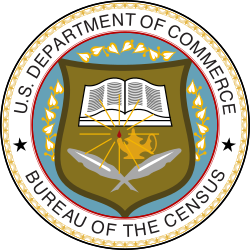| Eighteenth census of the United States | ||
|---|---|---|
| ||
 U.S. Census Bureau seal | ||
 1960 U.S. census logo | ||
| General information | ||
| Country | United States | |
| Results | ||
| Total population | 179,323,175 ( | |
| Most populous | New York 16,782,304 | |
| Least populous | Alaska 226,167 | |
The 1960 United States census, conducted by the Census Bureau, determined the resident population of the United States to be 179,323,175, an increase of 19 percent over the 151,325,798 persons enumerated during the 1950 census. This was the first census in which all states recorded a population of over 200,000. This census's data determined the electoral votes for the 1964 and 1968 presidential elections. This was also the last census in which New York was the most populous state.
Contents
- Census questions
- Data availability
- State rankings
- City rankings
- Locations of 50 most populous cities
- Notes
- External links
Detroit lost 220,000 residents in the 1950s, which remains the record for the largest loss of population between two censuses.

